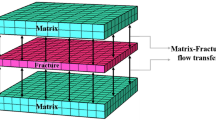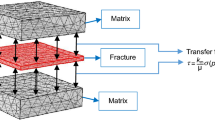Abstract
The matrix-fracture transfer shape factor is one of the important parameters in modeling naturally fractured reservoirs. Four decades after Warren and Root (1963, SPEJ, 245–255.) introduced the double porosity concept and suggested a relation for it, this parameter is still not completely understood. Even for a single-phase flow problem, investigators report different shape factors. This study shows that for a single-phase flow in a particular matrix block, the shape factor that Warren and Root defined is not unique and depends on the pressure in the fracture and how it changes with time. We use the Laplace domain analytical solutions of the diffusivity equation for different geometries and different boundary conditions to show that the shape factor depends on the fracture pressure change with time. In particular, by imposing a constant fracture pressure as it is typically done, one obtains the shape factor that Lim and Aziz (1995, J. Petrolean Sci. Eng. 13, 169.) calculated. However, other shape factors, similar to those reported in other studies are obtained, when other boundary conditions are chosen. Although, the time variability of the boundary conditions can be accounted for by the Duhamel’s theorem, in practice using large time-steps in numerical simulations can potentially introduce large errors in simulation results. However, numerical simulation models make use of a stepwise approximation of this theorem. It is shown in this paper that this approximation could lead to large errors in matrix-fracture transfer rate if large time-steps are chosen.
Similar content being viewed by others
References
G.E. Barenblatt I.P. Zheltov I.N. Kochina (1960) ArticleTitleBasic concept on the theory of homogeneous liquids in fissured rocks J. Appl. Math. Mech. 20 852–864
Bourbiaux, B., Granet, S., Landereau, P., Noetinger, B., Sarda, S. and Sabathier, J. C.: 1999, Scaling up matrix-fracture transfer in dual-porosity models: theory and application, SPE paper 56557 presented at the SPE Annual Simulation Symposium, Houston, Feb. 3–6
Chang, M. M.: 1995, Analytical Solutions of Single- and Two-phase Flow Problems of Naturally Fractured Reservoirs: Theoretical Shape Factors and Transfer Functions, PhD Dissertation, The University of Tulsa.
Coats, K. H.: 1999, Implicit compositional simulation of single-porosity and dual-porosity reservoirs, SPE paper 18427 presented at the SPE Reservoir Technical Conference and Exhibition, Houston, Oct. 3–6.
Hassanzadeh, H.: 2002, Naturally Fractured reservoirs modeling project, annual progress Report No. 1, University of Calgary, Alberta, Canada.
Kazemi, H., Merrill, L. S., Porterfield, K. L. and Zeman, P. R.: 1976, Numerical simulation of water-oil flow in naturally fractured reservoirs, SPEJ December, 317–326.
H. Kazemi J.R. Gilman (1993) Multiphase Flow in Fractured Petroleum Reservoirs J. Bear C.F. Tsang G. Marsily Particlede (Eds) Flow and Contaminant Transport in Fractured Rock Academic Press San Diego 267–323
K.T. Lim K. Aziz (1995) ArticleTitleMatrix-fracture transfer shape factors for dual-porosity simulators J. Petroleum Sci. Eng. 13 169 Occurrence Handle10.1016/0920-4105(95)00010-F
Nanba, T.: 1991, Numerical simulation of pressure transients in naturally fractured reservoirs with unsteady-state matrix-to-fracture flow, SPE Paper 22719.
B. Noetinger T. Estebenet P. Landereau (2000) ArticleTitleUp-scaling of double porosity fractured media using continuous-time random walks methods Transport Porous Media 39 IssueID3 315 Occurrence Handle10.1023/A:1006639025910
Noetinger, B. and Estebenet, T.: 1998, Application of random walk methods on unstructured grid to up-scale fractured reservoirs, presented at the 1998 European Conference on Mathematics of Oil Recovery, Peebles, Scotland, Sep 8–11.
N. Ozisik (1980) Heat Conduction Wiley New York
Penuela, G, Hughes, R. G., Civan, F. and Wiggins, M. L.: 2002a, Time-dependent shape factors for inter-porosity flow in naturally fractured gas-condensate reservoirs, SPE 75524, in: Proceedings of the 13th SPE/DOE Symposium on Improved Oil Recovery, Tulsa, OK, April 13–17.
Penuela, G. , Hughes, R. G., Civan, F. and Wiggins, M. L.: 2002b, Time-dependent shape factor for secondary recovery in naturally fractured reservoirs, SPE paper 75234.
M. Quintard S. Whitaker (1996) ArticleTitleTransport in chemically and mechanically heterogeneous porous media Advances Water Res. 19 IssueID1 29 Occurrence Handle10.1016/0309-1708(95)00023-C
Sarda, S., Jeannin, L, Basquet, R. and Bourbiaux, B.: 2002, Hydraulic characterization of fractured reservoirs: simulation on discrete fracture model, SPE Reservoir Eval. Eng. J. April, 154.
M.A. Sabet (1991) Well Test Analysis Gulf Publishing Company Houston
Stehfest, H.: 1979, Numerical inversion of Laplace transforms algorithm 368 communications of the ACM. 13(1), 47.
Thomas, L. K., Dixon, T. N. and Pierson, R. G.: 1983, Fractured reservoir simulation, SPEJ, February, 42–54.
Warren, J. E. and Root, P. J.: 1963, The behavior of naturally fractured reservoirs, SPEJ, September, 245–255.
Author information
Authors and Affiliations
Corresponding author
Rights and permissions
About this article
Cite this article
Hassanzadeh, H., Pooladi-Darvish, M. Effects of Fracture Boundary Conditions on Matrix-fracture Transfer Shape Factor. Transp Porous Med 64, 51–71 (2006). https://doi.org/10.1007/s11242-005-1398-x
Received:
Accepted:
Issue Date:
DOI: https://doi.org/10.1007/s11242-005-1398-x




